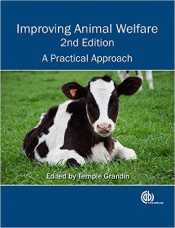 |
Improving Animal Welfare: A Practical Approach (2nd Edition)
Edited by Dr. Temple Grandin
Colorado State University, USA
ISBN: 978-1-78064-467-7
c. 368 pages
131 figures/illustrations
Subject Classifcation: KNAC, PSVP, TVH, TW
Territorial Market Rights: World
Published by CABI
Links for ordering:
- Amazon.Com
- CABI.org
|
Chapter 17: Successful technology transfer of behavioral and animal welfare research to the farm and slaughter plant.
by Temple Grandin, Colorado State University
There are many important research projects that have findings that could really improve animal welfare. Unfortunatley, the results of many of these projects are never transferred to the farm, transporters, or slaughter plants. This chapter explains how to improve the transfer of research results to the field. The author describes the successful development of a cattle restrainer system from the research lab to the meat industry.
Below is an excerpt from Chapter 17...
Principles of Successful Technology Transfer
Ethologists, veterinarians and animal scientists need to spend more time transferring the results of their research to industry. The author will now outline four steps that are required for successful transfer of research results from the lab to producers. These recommendations are based on years of work on improving livestock handling, inventing new equipment, and implementing animal welfare auditing programs.
Communicate your results outside the research community
It is important to publish your research in peer- reviewed scientific journals so knowledge does not get lost. Publishing in refereed journals also helps to ensure that the research results are verified by the use of good scientific methods. Researchers also need to publicize their work by giving talks and lectures, writing articles for industry magazines, and creating and maintaining web sites. One of the reasons the author was able to transfer cattle handling designs to the industry is that she wrote over 300 articles on her work for the livestock industry press. Every research project had several articles published about it. She also gave talks at producer meetings, and she posted her designs on her web site where anyone could download them for free. People are often too reluctant to give information away. The author discovered that when she gave lots of information away she got more consulting jobs than she could handle. She gave the standard designs away for free and made a living by charging for custom designs and consulting.
Make sure your early adopters do not fail
For a technology transfer to work, the first people who adopt it have to succeed. Researchers and developers need to choose companies with management that believes in what they are doing, and they need to inspect every detail. Early adopters must be supervised during every step of the installation and start-up to make sure that the new method works correctly. Choosing the right farm or plant to test new technology is critical. The place should have a manager who loves the project and is dedicated to making it work. A poor manager with a bad attitude can make a good system fail. The author had a promising technology fail because the plant manager was not interested in the project. The people at the corporate office wanted the project but the local plant manager did not like having the hassle of working on a new project.
Supervise other early adopters to prevent mistakes that could cause the method or technology to fail
Transferring the authorís center-track technology out of the first plant that used it successfully was very time consuming (Fig. 14.2). Lots of time was
spent on site at the next nine veal and beef plants to make sure the equipment had been installed correctly. The steel welding companies often made many poorly designed modifications. They thought they were improving the system but their modifications made it work worse. In half the plants the author visited, the author found either installation mistakes or modifications that would have caused the system to fail. Transferring the technology from the first plant to the next nine plants required more time and travel than installation in the first plant.
 Click here to return to the Homepage for more information on animal behavior, welfare, and care.
Click here to return to the Homepage for more information on animal behavior, welfare, and care.
 Click here to return to Dr. Grandin's Books and Video page.
Click here to return to Dr. Grandin's Books and Video page.
 Click here to return to the Improving Animal Welfare Table of Contents page and read other chapter excerpts.
Click here to return to the Improving Animal Welfare Table of Contents page and read other chapter excerpts.


 Click here to return to the Homepage for more information on animal behavior, welfare, and care.
Click here to return to the Homepage for more information on animal behavior, welfare, and care.